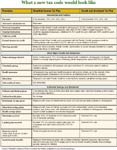Article
Will your favorite tax breaks disappear?
It all depends on whether some of these controversial recommendations become law.
If your tax strategy has included piling up high-dollar deductions such as mortgage interest, you'll need to rethink it if provisions recommended by a presidential tax re-form panel become law. That's far from certain, but the panel's recent report at least puts the issue on the table. The President's Advisory Panel on Federal Tax Reform was established in January 2005 not to reduce taxes, but to devise ways to make the tax code simpler, fairer, and more pro-growth.
It has presented two alternative plans. The intent of the first, the Simplified Income Tax Plan, is to streamline the current tax system by replacing its six brackets with four: 15 percent, 25 percent, 30 percent, and 33 percent. The aim of the second, the Growth and Investment Tax Plan, is to boost economic growth by reducing taxes on savings and investments. Under this plan, there would be three brackets: 15 percent, 25 percent, and 30 percent. Both plans have several common elements, which are outlined below.
You could lose your best deductions

Since households with higher income receive a disproportionate benefit from the home mortgage interest deduction, the panel proposes that tax benefits for home mortgage interest be retained but shared more evenly. It recommends a home credit equal to 15 percent of the amount of mortgage interest paid. The credit would be limited by regional housing prices, with a suggested eligible mortgage-debt cap from $227,000 to $412,000. In addition, mortgage interest deductions for second homes and home equity loans would be eliminated.
The current interest deduction is available up to $1.1 million of mortgage debt for those who itemize their taxes. To be fair to those who purchased or refinanced homes based on current law, the cap would be phased in over five years for pre-existing home mortgages. Joel Slemrod, Director of the Office of Tax Policy Research at the University of Michigan Business School, thinks "it's going to reduce demand for high-end housing, where people are now getting essentially a 35-percent subsidy because that's their tax bracket."
Also, under current law, a married couple who files jointly can exclude up to $500,000 ($250,000 for singles or married filing separately) of capital gains on a home that's been used as a principal residence for two out of the last five years. The panel would tweak that slightly to recommend that in order to qualify for the exemption an individual must own and use a home as a principal residence for three out of five years.
Also provoking debate is the proposal in both plans to eliminate the itemized deduction for state and local taxes. The impact of this change varies significantly depending on where you live. If you're in a state where you pay high property and state income taxes (California and New York, for example), you could lose a large deduction. The panel justifies this proposal by saying the current deduction is a federal tax subsidy for public services provided by state and local governments.
Dean Baker, co-director of the Center for Economic and Policy Research in Washington, notes: "State and local taxes will suddenly be much more onerous to people. This will likely produce substantial pressure for lower taxes in many states. If taxes are lowered, then the quality of services, such as education, roads, and public safety, would almost certainly suffer."
Both plans would also create a single Family Credit available to all taxpayers that would consolidate the standard deduction, personal exemptions, the child tax credit, and the Head of Household Filing Status. Dollar-for-dollar credits, not deductions, would be: $3,300 for married couples, $2,800 for unmarried taxpayers with child, $1,650 for singles, and $1,150 for each dependent taxpayer. There's an additional credit of $1,500 for each child and $500 for each other dependent. So a married couple with two children would earn a credit of $8,600. Moreover, the earned income tax credit and refundable child tax credit are replaced by a Work Credit, which will be coordinated with the Family Credit above. The maximum credit is $3,570 for a working family with one child. It increases to $5,800 for families with two or more kids.
Finally, both plans would say adios to the alternative minimum tax, to the relief of millions of taxpayers (21.6 million in 2006 and expected to grow to 52 million in 2015). However, while the AMT has been under fire for years, its removal will cause a shortfall of over a trillion dollars in revenues-which presumably will be made up by the changes to the other tax code provisions.
Proposals for retirement plans and investments
While there are no proposed changes for defined-benefit plans, the panel has recommended major changes for defined-contribution plans such as 401(k)s, 403(b)s, 457(b)s, and SIMPLE plans. Under both proposals, they would be consolidated into Save at Work plans. The controversial aspect of the proposal is that contributions would lose their pre-tax status under one plan, although distributions would be tax-free (think Roth-style plans). Brian Graff, Executive Director/CEO of the American Society of Pension Professionals & Actuaries, has called this proposed change devastating: "For low- and moderate-income workers, losing that upfront tax deduction is certainly going to influence their decision to contribute."
IRAs would be replaced by Save for Retirement accounts, which will have a $10,000 annual contribution limit. Similarly, Coverdell Education Savings Accounts, Section 529 plans, and Health Savings Accounts would be replaced by Save for Family accounts, which also have a $10,000 annual contribution limit. These contributions would be made on an after-tax basis and earnings would grow tax-free. The two plans differ on the treatment of dividends and capital gains, however. Under the Simplified Income Tax Plan, dividends of US companies paid out of their domestic earnings won't be taxable at all, and 75 percent of corporate capital gains from US companies would be excluded (the tax rate on the remaining 25 percent would vary from 3.75 to 8.25 percent). Interest from savings accounts, CDs, and the like would be taxable at regular income rates.
Under the Growth and Investment Tax Plan, dividends, capital gains, and interest will be taxed at 15 percent.
The panel's recommendations are being reviewed at the Department of the Treasury. Joel Slemrod feels the next signal, if anything, will come in the President's State of the Union Address in early 2006. "But it's hard to tell what will be favored and ultimately picked up from the panel report." And Dean Baker adds, "My best guess is that very little is likely to happen anytime soon. It would require some serious political momentum to move anything as big as this tax package, and a president with a low approval rating can't muster that momentum."





